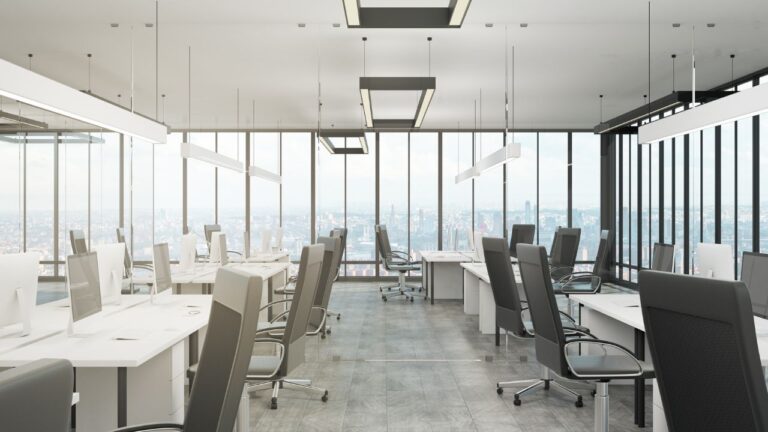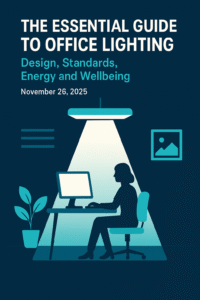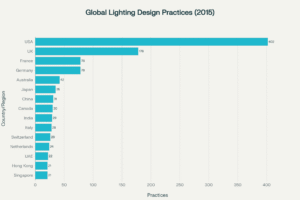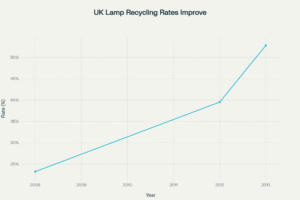Retrofitting your office lighting is one of the most effective ways to cut carbon, reduce operating costs, and create a more comfortable working environment. Yet environmentally responsible lighting goes beyond efficiency alone — it’s about how fittings are designed, made, used, and renewed.
At Lumenloop, sustainability is built into every stage of our process. From UK-made luminaires designed for disassembly to our Renew & Reuse programme, we make lighting that can be serviced, upgraded, and kept in use for decades.
LED lighting is vastly more efficient than legacy technologies: typical LED fittings deliver substantially lower energy use and much longer service life than fluorescent or incandescent equivalents.
| Lighting Type | Energy Consumption | Lifespan (hours) | Maintenance Costs |
|---|---|---|---|
| Incandescent Bulbs | High | 1,000 – 2,000 | High |
| High-Intensity Discharge (HID) Lamps | Moderate | 15,000 | Moderate |
| LED Lighting | Low | 50,000+ | Low |
Why Office Retrofits Need a Circular Approach
Lighting typically accounts for around 40% of an office’s electricity consumption, according to the International Energy Agency. Upgrading legacy fluorescent or halogen systems to high-efficiency LEDs can immediately reduce energy use by up to 70%, but the real sustainability gain comes from designing for longevity.
Many traditional fittings follow a linear path — manufacture, use, disposal.
Once a driver fails or technology improves, whole fixtures are thrown away. This approach adds to the UK’s growing electronic waste problem and wastes recoverable materials such as aluminium and rare-earth phosphors.
A circular model keeps those materials in circulation. By specifying remanufacturable luminaires, businesses can extend product life, maintain visual consistency across refurbishments, and drastically reduce waste.
Built to Be Renewed: The Lumenloop Difference
Every Lumenloop product is developed with renewability in mind.
Our Renew & Reuse process allows fittings to be serviced and upgraded at component level instead of being replaced.
Modular design: LED boards, optics, and drivers can be swapped independently.
Durable construction: Precision-engineered aluminium housings built to last.
Accessible fixings: Designed for easy disassembly and on-site upgrades.
Reputable components: Drivers and optics from Tridonic, Philips, and Ledil.
UK manufacturing: Reduced transport emissions and full material traceability.
This modularity is the foundation of renewable lighting. It enables specifiers and estate managers to plan lighting systems with long-term flexibility — not built-in obsolescence.
You can explore our full range of remanufacturable fittings on the Products page.
98% Recyclable Luminaires
Sustainability doesn’t stop at energy savings. Many of Lumenloop’s luminaires are 98% recyclable, ensuring valuable materials are recovered rather than discarded.
Bodies and heatsinks are made from extruded aluminium that can be recycled repeatedly without quality loss.
Diffusers and optics use recyclable polycarbonate and PMMA, while control gear and LED modules are easily separable at end of life.
Combined with our take-back and remanufacturing service, this approach means your office retrofit leaves a genuinely lighter footprint.

TM66 — Verified Circular Design
As the UK industry standard for sustainable lighting, CIBSE’s TM66 framework provides a measurable way to assess circular performance. It evaluates how products are designed, manufactured, maintained, and recovered.
All Lumenloop luminaires can be assessed under TM66, giving specifiers confidence that their lighting choices support corporate sustainability and Net Zero targets.
For consultants and architects, this also provides a straightforward path to BREEAM and LEED documentation.
How Environmentally Responsible Lighting Performs in Practice
An environmentally responsible lighting system delivers three simultaneous benefits:
Energy efficiency – High-efficacy LED sources and intelligent controls dramatically reduce running costs.
Resource efficiency – Modular construction keeps materials in use and reduces replacement waste.
Occupant wellbeing – Low-glare optics, precise colour rendering, and tunable control options create healthier, more comfortable workspaces.
Lumenloop luminaires can be specified with DALI, Casambi, or SwitchDIM controls, giving facility managers precise oversight of energy use through occupancy and daylight sensors.
You can explore configuration options using our Lighting Calculators — including ROI and carbon-saving tools for both office and warehouse environments.
Product Examples from Our Sustainable Range
| Product | Type | Sustainability Highlights |
|---|---|---|
| Vero 11 | Recessed downlight | Modular driver tray, recyclable aluminium housing, TM66-assessable |
| Axis 171 | Linear surface/suspended | Designed for disassembly, high efficacy, UK-made |
| Void 17 | Architectural downlight | Compatible with Renew & Reuse, 98% recyclable, modular assembly |
| Beam Emergency | Emergency fitting | Replaceable LED modules, recyclable housing, low standby consumption |
| Bright Emergency Bulkhead | Bulkhead | Circular construction, Tridonic control gear, extended lifetime |
Each of these products embodies our core design philosophy: durability, serviceability, and circularity.
The Broader Environmental Impact
According to WRAP UK, the built environment generates over a third of all waste in the UK.
Specifying lighting with a circular design helps reverse that trend.
Because lighting is replaced more frequently than other building systems, its design decisions have outsized influence on lifecycle emissions.
A remanufacturable luminaire can save hundreds of kilograms of embodied carbon compared with one-for-one replacements every few years.
When combined with renewable energy procurement and smart control strategies, environmentally responsible lighting becomes a key driver of Net Zero performance.
The Financial Case for Circular Lighting
Environmentally responsible lighting isn’t only about ethics — it’s good business.
Lower total cost of ownership: Modular upgrades mean you buy fewer new fittings over time.
Reduced maintenance costs: Component replacement takes minutes, not hours.
Stable visual quality: Renewed luminaires maintain design intent across the building.
Sustainability credentials: TM66 and recyclability scores strengthen ESG reporting.
This whole-life cost advantage makes Renew & Reuse particularly attractive for facility management, landlords, and design-and-build contractors who manage multiple office spaces.
Integrating Smart Controls for Maximum Savings
To make lighting truly efficient, it should work in harmony with occupancy, daylight, and energy monitoring systems. Lumenloop offers luminaires compatible with:
DALI addressable networks for granular dimming and zoning.
Casambi wireless control for flexible retrofit projects without new cabling.
Mains dimming or fixed-output options for simplicity in budget-sensitive upgrades.
These control options can reduce annual lighting energy use by an additional 20–30% compared with static systems — an easy win for operational carbon reduction.
For an instant estimate of potential savings, try our Lighting Calculators, including the LED Lighting Carbon Calculator.
How to Specify Environmentally Responsible Luminaires
When choosing fittings for an office retrofit, consider these five key features:
Modular design – ensures future upgrades without total replacement.
High recyclability – supports end-of-life recovery and reduces waste.
TM66 compliance – provides verified circularity metrics.
Local manufacturing – shortens supply chains and lowers embodied carbon.
Smart control compatibility – maintains ongoing energy efficiency.
Lumenloop’s UK-made range meets all five. Each fitting is designed for component-level access, tested for circular performance, and backed by our Renew & Reuse programme.
Building a Brighter, More Responsible Future
Lighting is central to how we experience the built environment — and how we shape its environmental footprint.
Choosing environmentally responsible lighting is an investment in both operational savings and long-term sustainability.
At Lumenloop, we combine precision engineering with circular-economy design principles to deliver luminaires that last longer, perform better, and waste less.
If you’re planning an office retrofit or sustainability upgrade, speak to our team about designing a circular specification that reduces carbon, protects budgets, and keeps your lighting future-ready.
👉 Contact us to request a lifecycle cost comparison or to discuss how our UK-made luminaires can support your sustainability goals.












